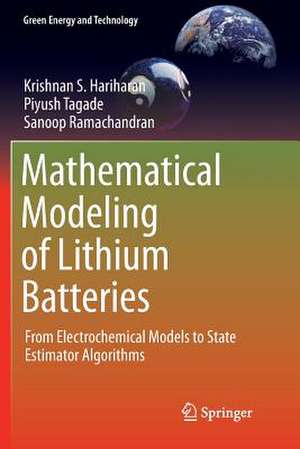Mathematical Modeling of Lithium Batteries: From Electrochemical Models to State Estimator Algorithms: Green Energy and Technology
Autor Krishnan S. Hariharan, Piyush Tagade, Sanoop Ramachandranen Limba Engleză Paperback – 6 iun 2019
Battery is an electrochemical system, and any level of understanding cannot ellipse this premise. The common thread that needs to run across—from detailed electrochemical models to algorithms used for real time estimation on a microchip—is that it be physics based. Build on this theme, this book has three parts. Each part starts with developing a framework—often invoking basic principles of thermodynamics or transport phenomena—and ends with certain verified real time applications. The first part deals with electrochemical modeling and the second with model order reduction. Objective of a BMS is estimation of state and health, and the third part is dedicated for that. Rules for state observers are derived from a generic Bayesian framework, and healthestimation is pursued using machine learning (ML) tools. A distinct component of this book is thorough derivations of the learning rules for the novel ML algorithms. Given the large-scale application of ML in various domains, this segment can be relevant to researchers outside BMS domain as well.
The authors hope this offering would satisfy a practicing engineer with a basic perspective, and a budding researcher with essential tools on a comprehensive understanding of BMS models.
| Toate formatele și edițiile | Preț | Express |
|---|---|---|
| Paperback (1) | 891.33 lei 43-57 zile | |
| Springer International Publishing – 6 iun 2019 | 891.33 lei 43-57 zile | |
| Hardback (1) | 896.19 lei 43-57 zile | |
| Springer International Publishing – 18 ian 2018 | 896.19 lei 43-57 zile |
Din seria Green Energy and Technology
- 18%
 Preț: 943.43 lei
Preț: 943.43 lei - 20%
 Preț: 629.52 lei
Preț: 629.52 lei - 18%
 Preț: 1124.92 lei
Preț: 1124.92 lei - 18%
 Preț: 947.35 lei
Preț: 947.35 lei - 15%
 Preț: 655.92 lei
Preț: 655.92 lei - 18%
 Preț: 957.62 lei
Preț: 957.62 lei - 18%
 Preț: 789.52 lei
Preț: 789.52 lei - 17%
 Preț: 464.55 lei
Preț: 464.55 lei - 15%
 Preț: 645.79 lei
Preț: 645.79 lei - 18%
 Preț: 903.93 lei
Preț: 903.93 lei - 24%
 Preț: 1322.07 lei
Preț: 1322.07 lei - 18%
 Preț: 890.54 lei
Preț: 890.54 lei - 18%
 Preț: 1115.46 lei
Preț: 1115.46 lei - 18%
 Preț: 1117.03 lei
Preț: 1117.03 lei - 18%
 Preț: 949.73 lei
Preț: 949.73 lei - 18%
 Preț: 892.11 lei
Preț: 892.11 lei - 15%
 Preț: 648.24 lei
Preț: 648.24 lei - 18%
 Preț: 997.09 lei
Preț: 997.09 lei - 15%
 Preț: 579.81 lei
Preț: 579.81 lei - 18%
 Preț: 1123.15 lei
Preț: 1123.15 lei - 18%
 Preț: 961.41 lei
Preț: 961.41 lei - 17%
 Preț: 490.22 lei
Preț: 490.22 lei - 18%
 Preț: 904.60 lei
Preț: 904.60 lei - 15%
 Preț: 643.34 lei
Preț: 643.34 lei -
 Preț: 287.90 lei
Preț: 287.90 lei - 24%
 Preț: 634.04 lei
Preț: 634.04 lei -
 Preț: 379.39 lei
Preț: 379.39 lei - 18%
 Preț: 783.20 lei
Preț: 783.20 lei - 18%
 Preț: 1394.84 lei
Preț: 1394.84 lei - 18%
 Preț: 1691.57 lei
Preț: 1691.57 lei - 18%
 Preț: 1112.48 lei
Preț: 1112.48 lei - 15%
 Preț: 592.61 lei
Preț: 592.61 lei - 18%
 Preț: 952.09 lei
Preț: 952.09 lei - 18%
 Preț: 944.19 lei
Preț: 944.19 lei - 18%
 Preț: 891.33 lei
Preț: 891.33 lei - 18%
 Preț: 1252.44 lei
Preț: 1252.44 lei - 18%
 Preț: 789.52 lei
Preț: 789.52 lei - 20%
 Preț: 566.29 lei
Preț: 566.29 lei - 18%
 Preț: 1113.71 lei
Preț: 1113.71 lei - 18%
 Preț: 1114.24 lei
Preț: 1114.24 lei - 24%
 Preț: 590.58 lei
Preț: 590.58 lei - 20%
 Preț: 567.49 lei
Preț: 567.49 lei - 24%
 Preț: 907.48 lei
Preț: 907.48 lei - 18%
 Preț: 952.89 lei
Preț: 952.89 lei - 18%
 Preț: 952.89 lei
Preț: 952.89 lei - 18%
 Preț: 950.52 lei
Preț: 950.52 lei
Preț: 891.33 lei
Preț vechi: 1086.99 lei
-18% Nou
Puncte Express: 1337
Preț estimativ în valută:
170.56€ • 178.52$ • 141.96£
170.56€ • 178.52$ • 141.96£
Carte tipărită la comandă
Livrare economică 31 martie-14 aprilie
Preluare comenzi: 021 569.72.76
Specificații
ISBN-13: 9783319791388
ISBN-10: 3319791389
Pagini: 211
Ilustrații: XIV, 211 p. 73 illus., 34 illus. in color.
Dimensiuni: 155 x 235 mm
Greutate: 0.45 kg
Ediția:Softcover reprint of the original 1st ed. 2018
Editura: Springer International Publishing
Colecția Springer
Seria Green Energy and Technology
Locul publicării:Cham, Switzerland
ISBN-10: 3319791389
Pagini: 211
Ilustrații: XIV, 211 p. 73 illus., 34 illus. in color.
Dimensiuni: 155 x 235 mm
Greutate: 0.45 kg
Ediția:Softcover reprint of the original 1st ed. 2018
Editura: Springer International Publishing
Colecția Springer
Seria Green Energy and Technology
Locul publicării:Cham, Switzerland
Cuprins
Lithium batteries and underlying electrochemical processes.- Electrochemical model (EM) for lithium batteries.- Electrochemical impedance spectroscopy (EIS) models.- Equivalent circuit models (ECM).- Reduced order models.- Battery management system – state estimator and algorithms.- Battery thermal models.- Battery life models.
Notă biografică
Dr. Hariharan’s research focuses on mathematical modeling of lithium batteries for industrial applications. During his research career, he has had the opportunity to develop electrochemical, impedance spectroscopy as well as equivalent circuit models for lithium batteries. In addition, Dr. Hariharan was also involved in developing battery state estimator algorithms and thermal analysis of cells as well as battery packs. During his tenure with General Motors R&D, he collaborated with algorithm engineers responsible for implementing on-board state estimators for electric vehicle (EV) programs. His research experience with various approaches in battery modeling would enable a successful monograph on state of the art in this emerging area.
Sanoop Ramachandran was born in Kerala, India in 1981. He got his BSc degree (2001) from the University of Calicut, Kerala, India. He obtained a Masters degree (2003) and PhD (2009) in Physics from the Indian Institute of Technology Madras, India. This was followed by two postdoctoral stints at the Tokyo Metropolitan University (2011), Tokyo, Japan and the Universite Libre de Bruxelles (2012), Brussels, Belgium. From late 2012 till date, he has been working as a Staff research scientist at the Samsung R&D Institute, Bangalore, India. He is an author of over 20 journal publications, several patents ideas and book chapters. His general research interests are in the field of soft-matter, electrochemistry as well as the use of mathematical modelling and computational tools for applied industrial research.
Textul de pe ultima copertă
This book is unique to be the only one completely dedicated for battery modeling for all components of battery management system (BMS) applications. The contents of this book compliment the multitude of research publications in this domain by providing coherent fundamentals. An explosive market of Li ion batteries has led to aggressive demand for mathematical models for battery management systems (BMS). Researchers from multi-various backgrounds contribute from their respective background, leading to a lateral growth. Risk of this runaway situation is that researchers tend to use an existing method or algorithm without in depth knowledge of the cohesive fundamentals—often misinterpreting the outcome. It is worthy to note that the guiding principles are similar and the lack of clarity impedes a significant advancement. A repeat or even a synopsis of all the applications of battery modeling albeit redundant, would hence be a mammoth task, and cannot be done in a single offering. The authors believe that a pivotal contribution can be made by explaining the fundamentals in a coherent manner. Such an offering would enable researchers from multiple domains appreciate the bedrock principles and forward the frontier.
Battery is an electrochemical system, and any level of understanding cannot ellipse this premise. The common thread that needs to run across—from detailed electrochemical models to algorithms used for real time estimation on a microchip—is that it be physics based. Build on this theme, this book has three parts. Each part starts with developing a framework—often invoking basic principles of thermodynamics or transport phenomena—and ends with certain verified real time applications. The first part deals with electrochemical modeling and the second with model order reduction. Objective of a BMS is estimation of state and health, and the third part is dedicated for that. Rules for state observers are derived from a generic Bayesian framework, and health estimation is pursued using machine learning (ML) tools. A distinct component of this book is thorough derivations of the learning rules for the novel ML algorithms. Given the large-scale application of ML in various domains, this segment can be relevant to researchers outside BMS domain as well.
The authors hope this offering would satisfy a practicing engineer with a basic perspective, and a budding researcher with essential tools on a comprehensive understanding of BMS models.
Battery is an electrochemical system, and any level of understanding cannot ellipse this premise. The common thread that needs to run across—from detailed electrochemical models to algorithms used for real time estimation on a microchip—is that it be physics based. Build on this theme, this book has three parts. Each part starts with developing a framework—often invoking basic principles of thermodynamics or transport phenomena—and ends with certain verified real time applications. The first part deals with electrochemical modeling and the second with model order reduction. Objective of a BMS is estimation of state and health, and the third part is dedicated for that. Rules for state observers are derived from a generic Bayesian framework, and health estimation is pursued using machine learning (ML) tools. A distinct component of this book is thorough derivations of the learning rules for the novel ML algorithms. Given the large-scale application of ML in various domains, this segment can be relevant to researchers outside BMS domain as well.
The authors hope this offering would satisfy a practicing engineer with a basic perspective, and a budding researcher with essential tools on a comprehensive understanding of BMS models.
Caracteristici
Evaluates and discusses various approaches to form one cohesive methodology for application and future development Considers recent trends and research to explore their potential and limitations to develop technology and efficient practices Provides a much-needed coherent framework of battery modeling techniques Includes supplementary material: sn.pub/extras
























